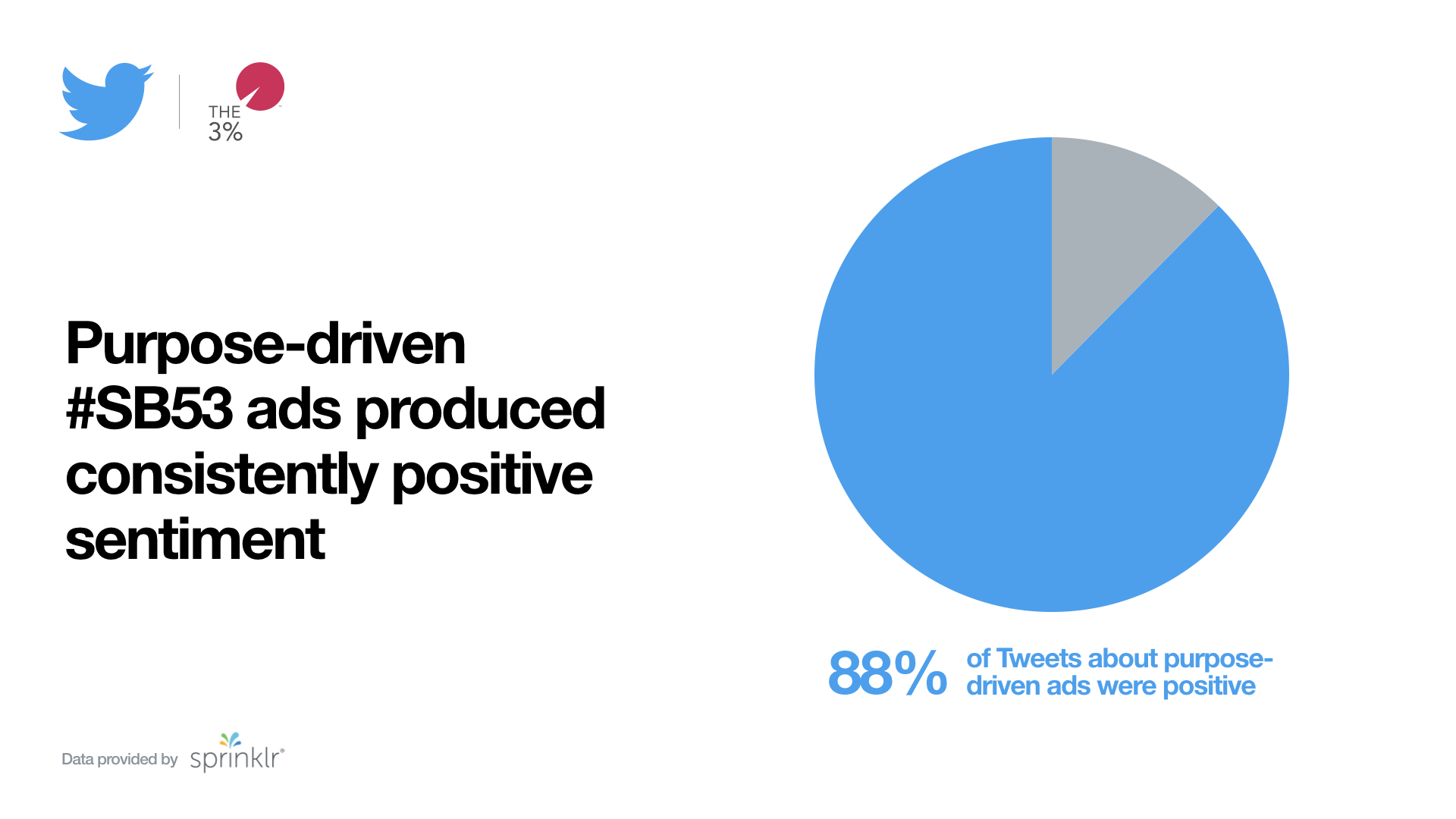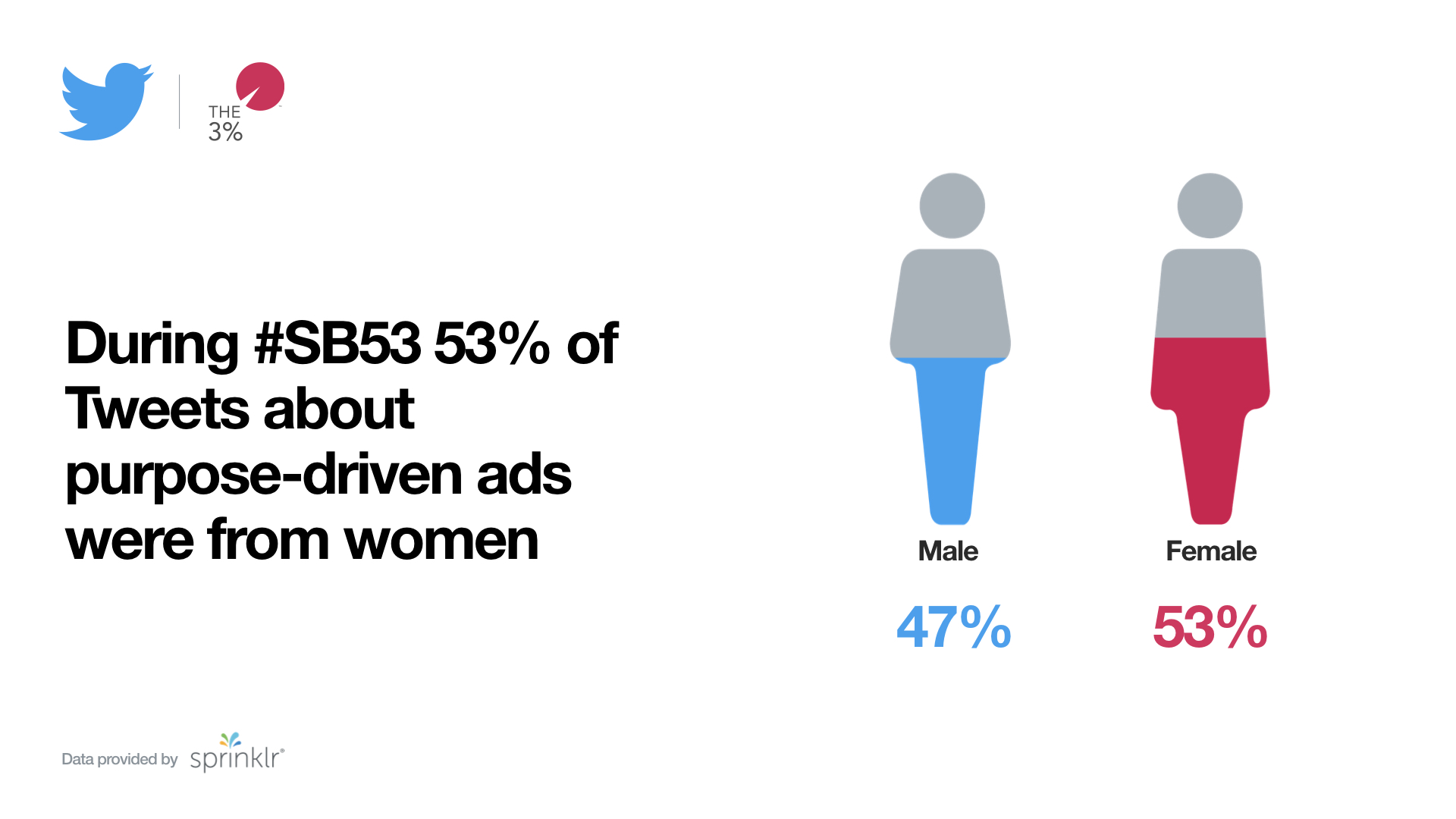Insights
5 ways brand purpose played a role in the big game

Purpose is happening: #SB53
Today’s consumers expect more from brands than just selling products. They prefer and identify with brands that reflect their values and beliefs. In 2018, from @Nike’s iconic #JustDoIt campaign to @Gillette’s polarizing #TheBestMenCanBe, marketers turned to Twitter’s influential and receptive audience as the best place to launch a purpose-driven message and get people talking.
To better understand the role brand purpose is playing in connecting with people on Twitter and the implications for marketers, we launched a research initiative to analyze the role purpose-driven messages played on advertising’s most Tweeted about day: #SB53.
In partnership with the 3% Movement and Sprinklr, we measured and analyzed Twitter conversation data investigating the response to purpose-driven advertisements vs. advertisements with standard brand messages during the big game.
Here are some of the notable takeaways:
1. Rise of brand purpose: 42% more brands activated a purpose-driven message on Twitter during #SB53 vs. #SB52
Aligning with the rise in marketers and consumers prioritizing purpose, many more brands activated a purpose-driven message on Twitter during this year’s game than last.

A few highlights:
@Microsoft’s powerful demonstration of its brand purpose to “empower every person and every organization on the planet to achieve more” showcasing its adaptive-controller technology that levels the playing field for gamers of all abilities.
@Budweiser told a story bigger than beer, showcasing its announcement to brew with 100% renewable energy sourced from wind power.
@Google shared an emotional tribute to veterans, and the central role its search product can play in helping them #FindWhateversNext.
“It’s no surprise to us that brands that are brave enough to lead change result in more consistently positive interactions and they also tend to produce more memorable ads, the ones people want to talk about well after the game has ended,” says Kat Gordon, founder and CEO of the 3% Movement.
2. Optimism > activism: Purpose-driven ads drove overwhelmingly positive conversation, striking unifying and optimistic tones
88% of Tweets about purpose-driven ads were positive compared to 74% of non-purpose-driven ads, according to Sprinklr’s social listening data. Brands took a noticeably progressive yet unifying tone in their messages versus past big games, largely avoiding political undertones or addressing divisive societal issues.

@Microsoft's darling #WeAllWin ad had the highest positive sentiment on Twitter out of any commercial during #SB53, generating mentions that were 95% positive, and 35% more positive than the most mentioned non-purpose-driven ad.
3. Purpose is contagious: Purpose-driven ads drove more meaningful Retweets than non-purpose-driven ads
Quote Retweets (Retweets where a user adds their own commentary) are a powerful way people can meaningfully personalize a message they’d like to spread. Over 60% of all Retweets of purpose-driven ads were Quote Retweets, compared to 33% of all Retweets for non-purpose-driven ads being Quote Tweets, indicating an increased level of emotional response to the purpose-driven messages.

@Verizon tapped into this behavior in the second year of its #AllOurThanks campaign encouraging users to Retweet its Tweet to show support for our nation’s first responders, with Verizon contributing $1 up to $1.5M to the @GarySineseFound for each Retweet.
This groundswell of earned Retweets drove both conversation and video views, helping @Verizon earn the inaugural #VideoReplay Award, which is given to the brand who drove the most video views on a single Tweet in Twitter’s official big game ads competition #BrandBowl53.
4. Women are driving the brand purpose conversation
The brand purpose conversation was driven by women, generating 53% of the overall conversation about purpose-driven ads vs. 47% of the conversation originating from men.

@Bumble's #InHerCourt campaign starring @SerenaWilliams, one of the first purpose-driven ads of the game, struck an exceptionally empowering tone, demonstrating the power that comes with making the first move — a core feature of its product.
5. Purpose has conversation staying power
@Microsoft's #WeAllWin purpose-driven statement was the only #SB53 brand campaign to increase in conversation volume the day after the game. With an 18% increase in mentions, @Microsoft showcased how the purpose-driven conversation uniquely has the ability to scale to new audiences on Twitter as more people find the message worth talking about, beyond a single launch moment.

What does this mean for marketers?
As consumers increasingly expect that brands play larger roles in societal issues, brands have an outsized ability to make an impact on culture. This data validates how the highly engaged, informed, and influential Twitter audience can propel a brand’s purpose-driven message — even on advertising’s most crowded stage.
Sprinklr Methodology:
Sprinklr collected and analyzed social data from Twitter in real time on Sunday, February 3, during the Super Bowl LIII game and post-game, 5:30pm EST to 11:59pm EST. The Sprinklr team utilized Sprinklr Listening to monitor all Tweets containing any of the following keywords: #SuperBowl53, #SuperBowl, #3PercentSB, or “Super Bowl.” All of these Tweets populated in a unified Sprinklr “listening topic.” This listening topic excluded Twitter mentions from bots, spammers, and any mentions containing profanity/inappropriate content.
Sprinklr took the baseline Super Bowl Twitter conversation from the listening topic and layered on “listening themes” for each brand that aired an advertisement on CBS during the game. A listening theme is a Sprinklr feature that allow users to layer on keywords, geographic information, profiles, and more on top of existing listening data for unified and detailed insights.
Each brand’s listening theme received a theme tag to reflect purpose-driven advertisements vs. non-purpose-driven advertisements. For example, the brand name “Gillette” and the hashtags #GilletteAd and #TheBestMenCanBe would be tagged in Sprinklr as “purpose-driven” if it appeared during the Super Bowl. Sprinklr artificial intelligence, called Intuition, provides Smart Alerts when there are volume spikes in the Super Bowl Twitter data related to brands. Sprinklr Intuition also analyzes Twitter data to detect trends in demographics, emojis, hashtags, and sentiment analysis to discover which gender is participating the most, what is the sentiment across popular hashtags, what are the most used emojis, and more. Furthermore, Sprinklr also analyzes share of voice by comparing the volume of Twitter engagement for every brand advertisement.
In this data analysis, Sprinklr applies the World Advertising Research Center’s (WARC) definition of brand purpose, "a reason for a brand to exist beyond making profit."